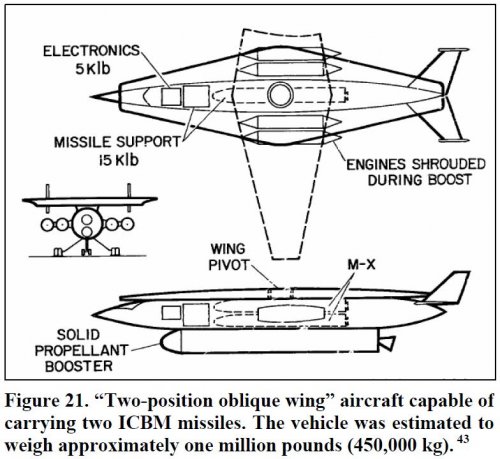- Joined
- 26 May 2006
- Messages
- 34,925
- Reaction score
- 15,796
From "A Summary Of A Half-Century of Oblique Wing Research" by Mike Hirschberg, David M. Hart and Thomas J. Beutner
From mid-1974 to mid-1975, Ames studied a “dash-on-warning” air mobile Intercontinental Ballistic Missile (ICBM) launch platform. This study, conducted for the Air Force Space and Missile Systems Organization (SAMSO), evaluated aircraft designs that could dash supersonically to a perimeter area and then loiter for six hours at a time – ready to air launch two internally housed ICBMs – each weighing 100,000 lb (90,700 kg). A total of eight configurations were explored, including two concepts that were called “two position oblique wing designs.” These two concepts (one of which is shown in Figure 21) used a rocket-boosted take-off to reach supersonic speeds with the wing completely rotated to 90°. It would then rotate to 0° for long term loiter. While not flying steady state with the wing at an oblique angle, it would still have transitioned between the two positions. No research appears to have been conducted into this transient wing movement, however. Another Ames study, conducted from early 1975 to early 1976 with the Naval Postgraduate School, developed a conceptual design of a “two-position oblique wing” carrier aircraft that was “armed with a special weapon system.” The wing was again rotated to the 90° position, this time for stowage on deck.
Attachments
Last edited by a moderator:

